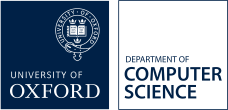Networks and Operating Systems: 2008-2009
Prerequisites | |
Lecturer | |
Degrees | Schedule S1(3rd years) — Computer Science Schedule B1 — Computer Science |
Term | Hilary Term 2009 (16 lectures) |
Overview
The Networks part of the course examines the science underpinning computer communications. Topics of interest will include the underlying physical media, the way data is represented, how errors in transmission can be detected and dealt with, the way information is routed over a large network, and the details of some actual network applications.
The Operating Systems part of the course aims to understand the construction and operation of a simple operating system, to discuss the principal problems to be overcome by an operating system, and structured ways of solving those problems.
Learning outcomes
At the end of the course the student will
- Understand the ways in which networked computers communicate with one another.
Synopsis
- Introduction: Requirement for communication; different sorts of network; layered protocols; connection-oriented and connectionless services.
- The Physical Layer: physical media; representing binary data.
- The Data Link Layer: Error detection and correction; flow control; channel allocation; protocols for local area networks.
- The Network Layer: Datagrams and virtual circuits; routeing; congestion control; internetworking; the network layer in the Internet.
- The Transport Layer: Connection management; the transport layer in the Internet; optimizations and congestion control.
- The Application Layer: Security; overview of some common applications.
- Operating Systems: Concepts, Structure.
- Process management: multi-processing; simple process scheduling; interprocess communication.
- Input/output: types of I/O devices; memory-mapped I/O; deadlock modeling and handling strategies.
- Memory management: partition schemes; swapping; paging; virtual memory; paging strategies; segmentation.
- File systems: file system management; file allocation table versus i-nodes; directories and their representation.
Syllabus
The need for computer networks; layered models; physical layer; data link layer; network layer; transport layer; application layer.
The role of an operating system; process management; input/output; memory management; file systems
Reading list
- Larry L. Peterson and Bruce S. Davie, Computer Networks: A systems approach (4th ed), Morgan Kaufmann, 2007.
- A. S. Tanenbaum, Computer Networks (3rd ed), Prentice-Hall International, 1996.
- A. S. Tanenbaum and A. S. Woodhall, Operating Systems: Design and Implementation (3rd ed), Prentice-Hall International, 1997.
Taking our courses
This form is not to be used by students studying for a degree in the Department of Computer Science, or for Visiting Students who are registered for Computer Science courses
Other matriculated University of Oxford students who are interested in taking this, or other, courses in the Department of Computer Science, must complete this online form by 17.00 on Friday of 0th week of term in which the course is taught. Late requests, and requests sent by email, will not be considered. All requests must be approved by the relevant Computer Science departmental committee and can only be submitted using this form.
